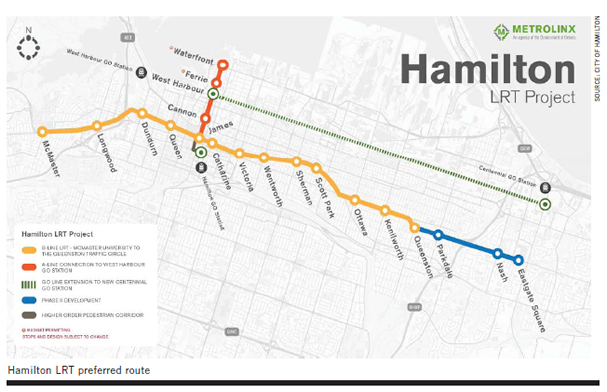
Modelling the traffic impacts of the LRT Managing Congestion
NRU
Aug. 10, 2016
By Leah Wong
Building the proposed Hamilton LRT will require changes to the road network. While the LRT will take cars off the road, the city’s population is growing and traffic management is required to reduce congestion as the road network changes.
Schedule 3 of the Growth Plan projects that by 2031 there will be around 660,000 people and 300,000 jobs in Hamilton. And with this growth city staff anticipates that congestion will increase on all transportation modes.
“Traffic volumes on Hamilton’s roads will naturally increase over time due to projected population and employment growth,” Hamilton LRT project coordination director Paul Johnson told general issue committee Monday.
As part of an update to its 2011 environmental assessment for the LRT the city is currently modelling the traffic impacts of its preferred LRT route. This modelling allows the city to understand where there will be increased congestion due to the LRT and what traffic management techniques could be used to reduce this congestion.
Staff and consultants Steer Davies Gleave presented a preliminary traffic modelling report to committee, building on their 2011 work. Though the preferred alignment has changed in that time, modelling shows that the updated route will have similar impacts on traffic to those previously identified.
“The modelling shows [traffic] getting pushed to parallel and peripheral corridors,” Hamilton LRT manager Trevor Horzelenberg told committee. He added that while these corridors can accommodate additional traffic it is likely drivers will experience longer travel times given the increase in population and the road network changes introduced to accommodate the LRT.
The consultants have taken a tiered approach— first considering a citywide perspective, then taking an LRT route perspective and finally taking a corridor perspective, which considers how the LRT will interact with traffic on a stop-by-stop basis.
Steer Davies Gleave associate Dennis Fletcher told committee that the consultants are presently working on modeling the area around the LRT route, which focuses on how individual intersections work and where mitigation efforts will be needed to improve the service levels.
Mitigation efforts are important to maintaining traffic flow, particularly at intersections where road users will experience changes in travel times. Without mitigation, modelling shows that the service level at the King and Gage intersection, for example, could increase from an average wait time of 10-20 seconds to more than 80 seconds.
“When it comes to the LRT project there are three factors around traffic—introducing the LRT and taking out road capacity, the increase in population and changes to the road network,” said Johnson. As the city’s population grows over the next 15 years there will be increased congestion with or without the LRT. But are ways to mitigate the LRT impact on the road network.
Through the corridor model, the consultants will explore ways to reduce delays at intersections once the LRT is running. These could include signal timing, changes to the lane configuration and turn restrictions. The results of the modelling to date, suggests that significant changes to the road system will not be needed to manage congestion.
Before the final report is presented to committee, staff and the consultants will identify capital projects needed to manage congestion. Johnson said that the city’s agreement with Metrolinx ensures that capital costs associated with traffic mitigation could be covered by provincial LRT funding. Meanwhile city staff is also preparing a transportation master plan, which is expected to be considered by council late in the fall.
Throughout September city and Metrolinx staff will host a series of open houses to further consult with the public on the LRT project. Council will vote on whether or not it wants to reaffirm support for the LRT at a special meeting on October 25.

